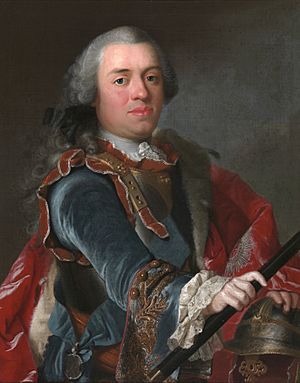William IV, Prince of Orange facts for kids
Quick facts for kids William IV |
|
|---|---|

Portrait of William IV (1751), attributed to Johann Valentin Tischbein
|
|
| Prince of Orange | |
| Period | 1 September 1711 – 22 October 1751 |
| Predecessor | John William Friso |
| Successor | William V |
| Prince of Orange-Nassau | |
| Reign | 1 September 1711 – 22 October 1751 |
| Predecessor | John William Friso |
| Successor | William V |
| Stadtholder of the United Provinces | |
| Reign | 4 May 1747 – 22 October 1751 |
| Predecessor | William III |
| Successor | William V |
| Born | 1 September 1711 Leeuwarden, Dutch Republic |
| Died | 22 October 1751 (aged 40) Huis ten Bosch, The Hague, Dutch Republic |
| Burial | 4 February 1752 Nieuwe Kerk, Delft |
| Spouse | |
| Issue Details... |
Carolina, Princess of Nassau-Weilburg Princess Anna William V, Prince of Orange |
| House | Orange-Nassau |
| Father | John William Friso, Prince of Orange |
| Mother | Landgravine Marie Louise of Hesse-Kassel |
| Signature | |
William IV (born Willem Karel Hendrik Friso; 1 September 1711 – 22 October 1751) was an important leader in the Dutch Republic. He was the Prince of Orange from the day he was born. He also became the first hereditary Stadtholder of all the United Provinces of the Netherlands in 1747. He held this powerful position until his death in 1751.
Throughout his life, William IV was also the ruler of the Principality of Orange-Nassau. This principality was located within the Holy Roman Empire.
Contents
Early Life and Becoming Stadtholder
William was born in Leeuwarden, a city in the Netherlands. His father was John William Friso, Prince of Orange, who led the Frisian branch of the House of Orange-Nassau. His mother was Landgravine Marie Louise of Hesse-Kassel. Sadly, William was born six weeks after his father passed away.
When his father died, William became the Stadtholder of Friesland and Groningen. A Stadtholder was a kind of governor or chief executive in the Dutch Republic. His mother acted as his regent, meaning she ruled for him, until 1731. In 1722, he was also chosen as the Stadtholder of Guelders.
For a long time, four other provinces of the Dutch Republic – Holland, Zeeland, Utrecht, and Overijssel – did not have a Stadtholder. This period was called the Second Stadtholderless Period. However, in 1747, these four provinces also decided to accept William as their Stadtholder. This made him the Stadtholder of all seven United Provinces.
Marriage and Family
In 1720, William was given a special honor: he became a Knight of the Order of the Garter. This is a very old and respected order in England.
On 25 March 1734, William married Anne, Princess Royal at St James's Palace in London. Anne was the oldest daughter of King George II of Great Britain and Caroline of Ansbach.
William and Anne had five children together:
- Two daughters who were stillborn (born 19 December 1736 and 22 December 1739).
- Princess Carolina of Orange-Nassau (born 28 February 1743 – died 6 May 1787). She later married Karl Christian of Nassau-Weilburg.
- Princess Anna of Orange-Nassau (born 15 November 1746 – died 29 December 1746).
- William V, Prince of Orange (born 8 March 1748 – died 9 April 1806). He would later become the next Stadtholder.
Later Life and Leadership
In 1739 and 1743, William inherited more lands and properties from other branches of his family.
Around 1740, a big conflict called the War of the Austrian Succession began in Europe. This war was about whether Maria Theresa had the right to become the ruler of Austria after her father, Emperor Charles VI, died.
The Dutch Republic decided to support Austria in 1747. They wanted to keep a safe area between themselves and France. Because of this, French troops invaded nearby lands. The Dutch Republic was facing problems from within, so its leaders decided they needed one strong leader. They turned to William and the House of Orange.
William and his family moved from Leeuwarden to The Hague. On 4 May 1747, the States General of the Netherlands officially named William the General Stadtholder of all seven United Provinces. This was a very important moment because they also made the position hereditary, meaning it would pass down in his family.
William IV was seen as a charming, well-educated, and skilled prince. Even though he didn't have much experience in governing, people liked him at first. He made some changes, like stopping a system where private contractors made a lot of money from taxes. However, he was also a leader in the Dutch East India Company, which was a powerful trading company. This led to stronger ties with wealthy business people, while the gap between the rich and the poor grew.
William served as the General Stadtholder of all the Netherlands until he died from a stroke in 1751 in The Hague.
Two places in the United States are named after him: Orange County in Orange, Virginia, and the city of Orangeburg, South Carolina.
Images for kids
-
Portrait of William by Jacques Aved, 1751
See also
 In Spanish: Guillermo IV de Orange-Nassau para niños
In Spanish: Guillermo IV de Orange-Nassau para niños



